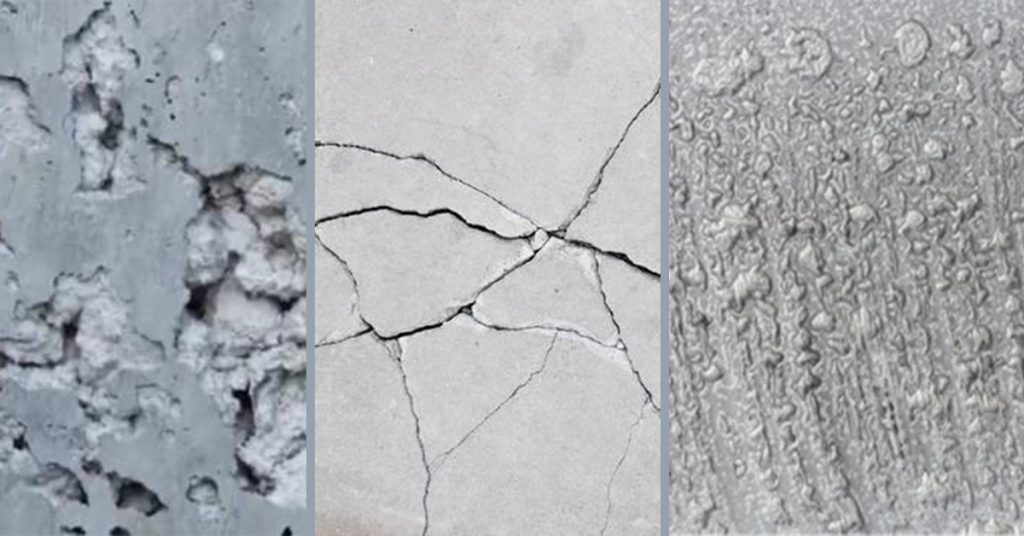Concrete is one of the most widely used construction materials in the world due to its strength, durability, and versatility. However, like any material, concrete is not immune to problems that can arise during or after construction. Understanding these common concrete problems, and their causes, and implementing preventive measures can help ensure the longevity and structural integrity of your concrete structures. In this blog, we’ll delve into some of the most common concrete problems, how to troubleshoot them, and steps to prevent their occurrence.
- Cracking
Cracking is perhaps the most common issue encountered with concrete. Cracks can appear for various reasons, including:
- Drying Shrinkage: Concrete contracts as it dries, leading to cracks.
- Temperature Changes: Rapid temperature fluctuations can cause thermal cracking.
- Overloading: Excessive weight or pressure can result in cracks.
- Improper Curing: Insufficient moisture during the curing process can lead to cracking.
Prevention: Ensure proper curing techniques, use of proper concrete mix designs, control temperature changes during curing, and provide adequate expansion joints to accommodate drying shrinkage.
- Scaling
Scaling refers to the flaking or peeling of the concrete surface, often due to freeze-thaw cycles, the use of excessive de-icing chemicals, or poor-quality concrete mixes.
Prevention: Use air-entrained concrete that is more resistant to freeze-thaw cycles, avoid overusing de-icing chemicals, and maintain proper drainage to prevent water accumulation.
- Spalling
Spalling occurs when pieces of concrete break off from the surface, exposing the aggregate beneath. This can result from corrosion of embedded steel reinforcement, especially in areas with high exposure to moisture and salt.
Prevention: Use corrosion-resistant steel, apply protective coatings to concrete surfaces, ensure proper drainage to minimize moisture infiltration, and maintain an adequate concrete cover over the reinforcement.
- Discoloration
Concrete discoloration can be caused by variations in cement color, improper mixing, or inadequate curing techniques.
Prevention: Use consistent raw materials, ensure thorough mixing, and follow proper curing procedures.
- Crazing
Crazing appears as a network of fine cracks on the concrete surface and is often caused by improper curing, rapid drying, or finishing the surface too soon.
Prevention: Implement proper curing methods, avoid rapid drying, and control the finishing process to ensure adequate moisture retention.
- Crusting
Crusting occurs when the surface of freshly poured concrete dries too quickly, forming a hard crust that prevents proper finishing and can lead to weakened concrete underneath.
Prevention: Use proper curing techniques such as covering the concrete with wet burlap or plastic sheets, and avoid exposing the surface to direct sunlight and wind.
- Honeycombing
Honeycombing is the presence of voids or air pockets in the concrete due to improper vibration during the pouring process.
Prevention: Properly vibrate the concrete during placement, use the right mix design to ensure adequate workability, and carefully monitor the pouring process.
- Aggregate Segregation
Aggregate segregation occurs when the different sizes of aggregate separate, leading to uneven distribution and weakening of the concrete mix.
Prevention: Use well-graded aggregates, adjust the mix design for proper workability, and avoid excessive handling and vibration during placement.
- Bleeding
Bleeding happens when excess water in the mix rises to the surface of the freshly poured concrete, resulting in a weakened surface layer.
Prevention: Control the water-cement ratio in the mix, use appropriate admixtures to improve workability, and avoid overworking the concrete during placement.
- Low Strength
Low concrete strength can occur due to incorrect mix proportions, inadequate curing, poor-quality materials, or improper testing procedures.
Prevention: Follow recommended mix design proportions, ensure proper curing conditions, use high-quality materials, and conduct regular strength tests.
In conclusion, understanding the common problems that can occur with concrete and taking proactive measures to prevent them is essential for constructing durable and long-lasting structures. By following proper construction practices, using quality materials, and implementing effective curing techniques, you can significantly reduce the likelihood of encountering these concrete issues. Regular inspection and maintenance also play a crucial role in ensuring the continued integrity of your concrete structures over time.

